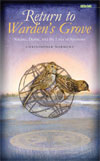book
Return to Warden's Grove: Science, Desire and the Lives of Sparrows
by Christopher Norment '82 :: University of Iowa Press :: Reviewed by Michael S. Webster

Spying on birds in the far north
Warden's Grove is a tiny cluster of spruce trees in the generally treeless expanse of the north Canadian tundra, and Christopher Norment – who received his master's degree from WSU in 1982 – spent three long summers there studying sparrows; this excellent little book is his account of those summers. Readers expecting a tale of high arctic adventure will be disappointed – there are no attacks by ferocious grizzlies, no horrifying acts perpetrated by men made desperate by starvation, and no daring escapades by intrepid explorers of the last frontier. Instead, Norment delivers a tale of patient waiting and watching, of detailing the daily lives of tiny birds, and it is riveting.
The story that Norment tells is an unusual glimpse into the mind, and heart, of a field biologist. Those of us who follow this bizarre career path don't do it for fame or fortune (there is little of the former in this work and even less of the latter!). Instead we do it for one simple reason: we are driven by curiosity about the natural world. Norment captures this intense curiosity beautifully – he clearly cares deeply for the little birds he studies and the land that they live in. The book describes nicely the mix of excitement and drudgery that is field biology: banding and measuring birds, endless searching for nests, sitting for hours swatting mosquitoes while watching parent birds deliver food to their nestlings. As Norment himself points out, the science in this book is decidedly low-tech. Nevertheless, it is important in some more subtle way: "the best end to my efforts lay in illuminating something of the life of a small bird and that this light, however feeble, helped connect me, and by extension, others, to the great world."
This book also succeeds because Norment can really write. He grapples with some weighty topics – our place in nature, the relationship between science and art, the meaning of a man's life – and it would be easy to slip into pretentious armchair philosophizing, but Norment never goes there. He is philosophical, to be sure, and thinks deeply, but he is never preachy and instead comes across as a thoughtful friend kicking around a few ideas. Norment's words draw the reader in, making even the most seemingly mundane topic interesting. He gives us an entire chapter on the differences between scientific writing and "normal" writing, another on shooting birds for research collections, and many pages on the lives of his favorite birds. And through it all Norment keeps you glued to the page and wondering – Why do scientists write that way? How should we feel about "collecting" birds for research? And what on earth ever happened to Mrs. Green's fledgling after it left the nest?
Finally, Norment's book captures the splendid isolation of the wilderness. In a world rapidly filling with humans, it is difficult to find a corner that doesn't have a Starbuck's; the arctic tundra is one of the few remaining exceptions. With only himself and a single field assistant for companionship, Norment both revels in and fears the solitude, and you feel it with him. This is a beautifully written little book, and one that will carry you to that tundra solitude.
— Michael S. Webster, Associate Professor of Biology